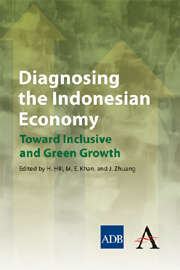Book contents
- Frontmatter
- Foreword
- Preface
- Author Profiles
- Abbreviations and Acronyms
- Contents
- 1 Introduction
- 2 Development Policies and Performance
- 3 Critical Constraints to Growth
- 4 Critical Constraints to Reducing Poverty and Inequality
- 5 Macroeconomic Management
- 6 Industrialization: Patterns, Issues, and Constraints
- 7 Infrastructure Development: Challenges and the Way Forward
- 8 Human Capital and Economic Development
- 9 Economic Growth, Employment Creation, and Poverty Alleviation
- 10 Poverty Reduction: The Track Record and Way Forward
- 11 Decentralization
- 12 Making Indonesia's Growth Green and Resilient
- Index
3 - Critical Constraints to Growth
Published online by Cambridge University Press: 05 May 2012
- Frontmatter
- Foreword
- Preface
- Author Profiles
- Abbreviations and Acronyms
- Contents
- 1 Introduction
- 2 Development Policies and Performance
- 3 Critical Constraints to Growth
- 4 Critical Constraints to Reducing Poverty and Inequality
- 5 Macroeconomic Management
- 6 Industrialization: Patterns, Issues, and Constraints
- 7 Infrastructure Development: Challenges and the Way Forward
- 8 Human Capital and Economic Development
- 9 Economic Growth, Employment Creation, and Poverty Alleviation
- 10 Poverty Reduction: The Track Record and Way Forward
- 11 Decentralization
- 12 Making Indonesia's Growth Green and Resilient
- Index
Summary
Indonesia's investment level was 30%–32% of gross domestic product (GDP) during 1990–1997 but the level plummeted to 11% of GDP in 1999 following the Asian financial crisis. The investment level has since recovered somewhat and was about 25% of GDP in 2007 and 2008 (Figure 3.1). However, as in the case of GDP growth, the recovery fell well short of the level that prevailed prior to the crisis. Moreover, it does not compare favorably with the region's faster growing economies—e.g., Viet Nam's 41.1% of GDP and Thailand's 28.8% in 2008.
Attaining the pre-crisis pace of GDP growth may not be possible unless investment is revived to that period's level. The private sector will need to be the driver of growth in the medium to long term. Public investment will also need to be boosted to address constraints related to the availability, reliability, and efficiency of infrastructure, and to meet the human capital needs. This chapter looks at the factors that may be constraining the Indonesian economy from attaining its pre-crisis levels of investment and growth. Specifically, the chapter asks if Indonesia's investment and growth are being constrained by high cost of finance, low social return to investment, and/or low appropriability of that return.
Cost of Finance
A comparison with other major economies in Southeast Asia suggests that Indonesia's domestic real interest rate is relatively high. Since the 1997 Asian financial crisis, Indonesia's real lending rate has remained higher than the rates of the region's other major economies except during the period of high inflation from late 2005 through early 2006.
- Type
- Chapter
- Information
- Diagnosing the Indonesian EconomyToward Inclusive and Green Growth, pp. 33 - 86Publisher: Anthem PressPrint publication year: 2012



